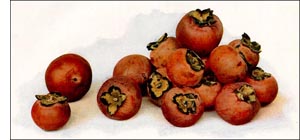Persimmon fruit
 The Persimmon, or Virginian Date Plum, is a North American tree, growing wild in nearly all of the southern United States, and will thrive and ripen its fruits as far north as the state of Connecticut and the Great Lakes.
The Persimmon, or Virginian Date Plum, is a North American tree, growing wild in nearly all of the southern United States, and will thrive and ripen its fruits as far north as the state of Connecticut and the Great Lakes. It is one of about one hundred and eighty species belonging to the genus Diospyros. These are all hardy trees or shrubs. Representatives of the genus are found in nearly all regions that have a tropical or a temperate climate.
Only a few of the species are cultivated. These are highly ornamental trees with a beautiful foliage, which is rarely attacked by insects. The common persimmon of America is the only species that is at all hardy in the north. This and the Japanese species are the only trees that produce the edible fruit commonly found in the market. The wood of nearly all the species of Diospyros is hard and close-grained.
The trees that yield the beautiful ebony of commerce belong to this genus, and the species that is said to yield the best quality of this wood is a native of the East Indies and Ceylon. It is also cultivated to some extent in hothouses and in tropical climates.
The common persimmon of the United States is a tree usually growing to a height of about fifty or sixty feet and rarely reaching one hundred feet. This is a beautiful roundtopped tree with more or less spreading branches. The name persimmon is of Indian origin and of unknown meaning. The fruit of this species is but lightly appreciated, except by those who visit the forest regions in which it is native, for it is only cultivated to a very limited extent.
The fruit is globular in form and quite plum-like. It varies both in size, color and flavor. When green the fruit is astringent and has a very disagreeable taste. This, however, disappears when the fruit becomes fully matured.
Persimmon picture